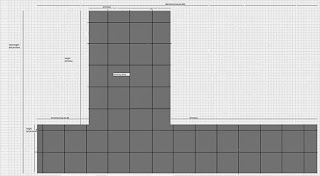You've been looking at cement tile patterns for months, debated color schemes and palettes, considered custom cement tile options and now are ready to order the tile! STOP!
| Cement Tile with Traditional Rug Design |
There are two layouts to consider when you install patterned cement or concrete tile:
1. Framed or Rug design uses a border and plain tile to frame the main field pattern. Achieve the classic look of a tile rug on your floor with a border. The border cement tiles should frame the patterned field tiles and provide interest without distracting your eye from the main field pattern.
| Rendering of a Cement Tile Rug with Border and Plain Tile |
2. Full pattern repeat is where the pattern runs to the edge of the room or space and isn't framed with other tile patterns. This works great for irregular-shaped rooms or for a slightly more contemporary look.
| Cuban tiles in this entryway are run to the edge of the room for a full pattern repeat. |
Cement Tile Design Tips for Full Repeat Patterns
 |
| Backsplash Layout with Large Dark Grid Lines showing placement |
Cement Tile Design Tips For Rug Layouts
Rug layouts are the most difficult, so start with a scale drawing of the area to be tiled. Find the center of the room and start your pattern for the main field in the center, too. Working out to include the border at least one tile width away from any irregular shapes or walls. Avoid cutting tiles for any reason that are inside the rug.
For a quick way to determine the number of tiles required and the approximate rugs sizes, I recommend creating a scaled grid that overlays the area to be tiled. It allows you to easily sketch out the rug and move it until you are pleased with the layout. It’s a great way to estimate the tiles and determine the size of the rug. You'll need to determine the rug dimensions in order to calculate the required border tiles.
In this recent customer layout, using a grid overlay, we could quickly center the rug for each area and then resize to make sure we didn't get too close to an edge, as well as account for irregular shapes, and have a full repeating quarter design pattern.
A grid pattern & scale drawing provide a quick rug design layout
|
Remember, DO NOT run the border right to the edge of the room. Leave at least 3- to 4-inches between the outside border and edge of the room for a plain, solid color "fill tile." Room edges are never square and cuts to the border will emphasize this, thereby guaranteeing an unprofessional or undesirable result. Cuts that are not true or square won't show on a plain tile because there is no pattern.
This grid overlay method works well for estimating tile quantities and approximate rug size; but, it’s still a good idea to have a detailed layout drawing or finished floor schedule. In fact, a detailed layout drawing will provide the best idea of look, point out any flaws with the layout, and clearly communicate your desires to the installer. With a detailed drawing you can better visualize the space and you might be surprised what will work.
For instance, in the design below, the customer decided that a full pattern repeat wasn't required for the short part of the L-shaped rug below. While I recommend keeping a full pattern repeat on most rug layouts, I love this layout and agree with the customer that it really works. The detailed drawing helped us find the balance between border, pattern and background it a tight and somewhat awkward space.
 |
| A detailed layout drawing is the best way to visualize the layout |
Cement Tile Design Inspiration
We hope this post offered you a better understanding of tile rugs, how to create cement tile patterns, when to use plain tiles, and why a layout is so valuable. If you still aren't sure what design, floor play or layout is right for you, then let us lend a design eye. We'll help you find inspiration that is right for you! Take a look at these featured installations:
- Cement Tile Design Ideas
- Cement Tile Rugs on Pinterest
- Houzz Cement Tile Rug
- Cement Tile Installation #1 on Flickr
- Cement Tile Installations #2 on Flickr
| Cuban Heritage Cement Tile Pattern with Full Repeat |
Cement Tile Design Resources
- Tips for a Successful Cement Tile Layout
- Tile Layout - Planning and Preparation are the Keys
- Create a Cement Tile Layout with Double Borders
- Create a Cement Tile Layout with Large Patterns & No Border
- Using Cement Tile Borders
- Tips for a Cement Tile Rug Design
- Frequent Questions About Cement Tile
- How to Customize Cement Tile
| Cement tile rug with plain yellow tiles for the field. |
Let our passion for cement tile help you!
Our passion for cement tile has led us to create one of the broadest collections of cement tile anywhere. Our experience and knowledge of this hand-crafted product will guide you to make the right decisions
With over a decade of experience selling cement tile, we care intensely about finding the right cement tile for you! Visit our handmade cement tile information center, you 'll find links to resources that will answer all your questions about cement tiles. If you don t find answers, let us know by completing our Request Information form, or by calling us during business hours at 888.739.4972 9-5 PST M-F. We look forward to talking cement tile with you.



No comments:
Post a Comment